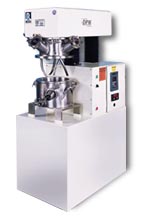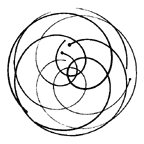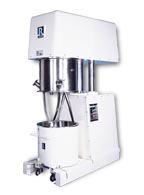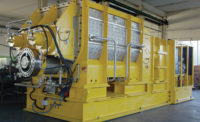New Blade Design Gives Double Planetary Mixer a Bright Future

- No Space Age metallurgy or microelectronics.
- No complex chemistry.
- Just a new design idea that solves a 50-year-old challenge in high-viscosity mixing.
The innovation that is suddenly stirring up excitement in the world of high-viscosity mixing is the HV Blade (patent pending) that Charles Ross & Son Co., Hauppauge, N.Y., recently introduced along with the new DPM Double Planetary Mixer. According to Doug Cohen, Ross vice president of Technical Services, the HV Blade is fundamentally different than any planetary blade seen before.
"With the down-thrust action generated by its helical geometry, along with the absence of a lower crossbar," says Cohen, "the HV Blade is capable of handling materials at viscosities far beyond the capabilities of conventional double planetary blades."
A New Look at Planetary Mixing
A bright idea is especially illuminating when it suddenly allows us to see something familiar from a new perspective. Double planetary mixers have been around for more than 50 years, but the fast pace of innovation during the first 30 years slowed to a crawl during the last 20 years. Manufacturers continued to make double planetary mixers larger, stronger and more capable with options like vacuum, discharge systems and change-can mix vessels. But these were relatively small, evolutionary steps. The mixers themselves remained more or less the same.Based on the mixing functions it could perform, the double planetary also settled into a fixed position in the pecking order of mixers. Multi-shaft mixers handled materials at lower viscosities than the double planetary, and applied greater shear. Meanwhile, double-arm kneaders handled the really heavy stuff - highly filled adhesives, heavy silicone and butyl sealants, and bulk molding compounds. The double planetary mixer has traditionally been considered appropriate for many adhesives and sealants, too, but only in viscosities up to approximately 1.5 million centipoise (viscosity is useful as a general indicator).
For the adhesives and sealants manufacturer, recognizing the boundaries that separate the capabilities of one mixer from those of another is critically important because these distinctions generally correlate with substantial differences in cost. The purchase price of a double planetary mixer, for example, is significantly greater than that of a comparable multi-shaft mixer.
On the other end of the scale, a double-arm mixer commands about three times the price of a double planetary mixer. Since the double-arm mixer is a horizontal unit, it also requires more space on the plant floor, and it introduces many potential problems with shaft seals, stuffing boxes and packing glands submerged in the product zone. The double-arm unit generally operates with more horsepower and consumes more energy day in and day out. Because of its horizontal orientation, it also cannot be supported with a set of several interchangeable mix vessels ¿ an option that often elevates double planetary mixing to a semi-continuous process. On the bottom line, the double-arm unit is the mixer of choice only when the double planetary mixer is not a viable choice.
"The real value of the new HV Blade technology rests on the boundary that separates the work of a double planetary mixer from that of a double-arm mixer," says Ed Bosch, Ross director of Product Development. "Because the HV Blades can increase the working viscosity of the double planetary mixer to beyond 5 million centipoise, it offers adhesives and sealants manufacturers a new option for producing high-viscosity products and reducing costs."

A 50-Year-Old Problem - and a new solution
A double planetary mixer designed for high-viscosity materials is a low-speed, high-torque machine with awesome power. In fact, the usefulness of the double planetary mixer is usually not limited by its ability to move a heavyweight material in the mix can - but by the behavior of extremely heavy materials when they are moved by conventional blades. Many highly filled materials eventually reach a point in the mix cycle at which they begin to 'climb' up conventional blades. First, the material clusters around the shoulders of the blades, separating from the bulk below. It quickly collects on the shafts and climbs upward into the vacuum hood, charging ports and seals. It can even infiltrate shaft seals. Mixing efficiency drops precipitously, and a difficult cleaning problem is created.
The HV Blade Design Concept
"To solve the 'climbing' problem, blades were needed that would force heavy materials back down into the mix vessel," says Bosch. "To succeed in mixing extremely heavy materials, the blades required a streamlined design - with no horizontal crossbar to provide support at the lower end of the blades. These were the design goals that eventually led us to the HV Blade concept."Helical down-thrust configuration - Unlike traditional, rectangular planetary blades (see sidebar, "Double Planetary Mixing Action," page 33), the HV Blade is sloped in a precisely angled, helical contour. This sweeping curve firmly pushes the batch material forward and downward, yet it presents far less resistance than the vertical bars of the traditional planetary blade.
Flattening torque and power spikes - Anyone who has used a double planetary mixer knows that the vertical configuration of the traditional blade creates another problem that is more serious than simple resistance to movement through the batch. Each time the vertical bars of the two blades pass in the vessel, a significant shearing event takes place. At that moment, a surge in power is required and a spike in amperage is generated.
Thanks to their helical design, the HV Blades pass one another in a nearly continuous slicing motion. The result is a balanced load, and the amperage spike is eliminated. This is a key factor in the mixer's ability to handle extremely high viscosities.
Section view: The leading and trailing edges - The leading edge of the HV Blade is flat, while the trailing edge is curved. This enhances the downward thrust imparted to the batch, while it prevents the formation of "dead zones" in the wake of the blade.
Lower crossbar eliminated - The lower crossbar on a traditional planetary blade serves two functions during mixing. It supports the vertical bars and provides rigidity. Continuously sweeping the bottom of the vessel, it also promotes flow upward into the center of the batch - improving heat transfer.
Laboratory testing has shown that as viscosity reaches extremely high levels, the value of this scraping action diminishes, while the resistance posed by the crossbar becomes a serious liability. By eliminating the lower crossbar, the HV blades are able to travel through the batch much more easily - which helps to increase their working viscosity range substantially. The HV Blades are engineered to operate without any need for the additional rigidity that a lower crossbar would provide.
After the mix cycle is completed, the crossbar presents another problem. Highly filled adhesives and sealants often stick tenaciously to the lower crossbar of a traditional planetary blade when the blade is removed from the batch. With a heavy material, this creates a tough cleaning job. The HV Blades eliminate this problem.
Selecting High-Viscosity Applications
1. Thick and sticky - "The HV Blades should be considered for materials that are extremely viscous, and especially if they are extremely sticky as well," says Bosch. "Heavy hot melts and silicone sealants, bulk molding compounds, and liquid-butyl sealants that are highly filled with such solids as calcium carbonate, fumed silica and TiO2 would all be excellent candidates.
"The HV Blades are not well-suited for solid-butyl sealants, because they are not designed to masticate solid chunks of rubber as a double-arm mixer can. But when the material is sticky, the HV Blades excel while the broad surface area of the double-arm machine prevents it from mixing effectively. The material often clings to the double-arm blades and simply revolves without much mixing action."
2. Fibrous fillers - Many sealants that include carbon or Kevlar™ fillers are difficult to mix in a double planetary mixer with conventional blades because they are particularly inclined to climb the blades. They are also likely to cling to the lower crossbar when the blades are withdrawn from the batch. These tendencies make fibrous materials ideal applications for HV Blades.
The Last Step: Testing to Confirm Blade Selection
Regardless of the blade design that seems appropriate for a particular application, laboratory testing is almost always essential to confirm the choice. "Test with the materials you will be using on your process line," says Bosch. "The goal is to replicate the process as closely as possible to be sure of the results you can expect in production."But remember, the success of your mixing system depends on more than just your equipment. Your mixing technique is also critical, and this is another reason why lab testing is so important. Testing provides an opportunity to refine your mixing technique under controlled conditions, with support staff on-hand, in order to optimize the performance of your equipment."
To learn more about Ross planetary mixers and HV Blades, or to arrange a demonstration, contact Bogard Lagman, executive vice president, Charles Ross & Son Co., 710 Old Willets Path, Hauppauge, NY 11788; phone 800-243-ROSS (United States), 631-234-0500 (overseas); fax 631-234-0601; e-mail sales@mixers.com.

Sidebar: Double Planetary Mixing Action
The double planetary mixer is used in process industries worldwide because it is a remarkably efficient design for mixing high-viscosity materials quickly. The two planetary blades pass through every point in the mix vessel in only a few minutes - positively mixing heavy, non-flowing products with great power.1. Each of the two blades revolves on its own axis.
2. Meanwhile, each blade advances along the vessel wall as the two blades orbit the vessel on a common axis.

Blade Designs
Traditional, rectangular planetary blades (photo at left below) are the most common choice for double planetary mixers. With angled surfaces on the vertical flights and the lower crossbar, these blades promote effective axial and radial flow for most materials. Scrapers are often mounted on the blades to continuously remove material on the vessel bottom and improve heat transfer.
The new HV Blade concept is designed primarily to force material downward while it also moves the material laterally. This combined motion promotes mixing while it prevents highly filled material from ¿climbing¿ the blades, defeating the mixing process and creating a labor-intensive clean-up problem.

Sidebar: Where Double Planetary Mixing is Headed
The future for double planetary mixing will include an increasing emphasis on automation, integration in plant-management systems and simplification on the plant floor.Next-generation control systems are already integrated in the machine design (rather than a separate stand-alone unit), prewired and preprogrammed for fast start-up. This minimizes disruption in production while new equipment is installed. It also reduces the costs and clutter of cabling in the plant.
Soon, even small units will be controlled individually by on-board PLCs. This will allow much greater flexibility for powerful data acquisition and management, and recipe-based process management. Operators will be able to switch product recipes with a few keystrokes - for faster changeover and greater end-product consistency. These PLCs can operate as stand-alone units, or they can easily be networked with the plant's overall production-management system.
The push to streamline and consolidate plant equipment is reflected in the design of the mixer shown here. A fully enclosed bonnet conceals the entire drive assembly. The base encloses the lift assembly, control system and also several pieces of auxiliary equipment (such as heat-transfer equipment and vacuum pumps) that would otherwise require separate space and cabling on the plant floor.
Automated turntable systems will also become common in the years just ahead. By automating the four key functions in mixing - charging, mixing, discharging and cleaning - these systems can improve product consistency while they reduce labor costs. The next logical step in change-can mixing, the turntable-based system, is highly modular. Because it is built with batch equipment, it allows easy process changes while it offers the efficiency of a nearly continuous mixing system.
Looking for a reprint of this article?
From high-res PDFs to custom plaques, order your copy today!




